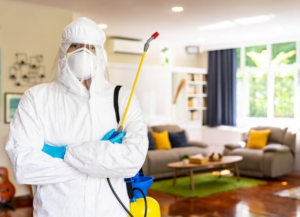Exterminator Sherman Oaks is a professional who uses methods to prevent or remove pests from homes, businesses, and other environments. This can include removing or sealing entry points, using chemical treatments, or setting traps. Exterminators also provide recommendations for long-term prevention.
Before beginning treatment, an exterminator will thoroughly inspect the area and identify the type of pest. This will help them create a plan to eliminate the pests and prevent them from returning.

An exterminator is a person who gets rid of pests such as beetles, bed bugs, ants, and cockroaches in residential and office environments. In most states, they are required to be licensed and certified to perform pest control. These professionals are usually skilled in both chemical and organic methods of pest control. In addition to removing pests from buildings, they also advise clients on ways to prevent future infestations.
Unlike some people who think that an exterminator is someone who completely destroys pests, these individuals are actually specialists in the biology and behavior of these unwanted creatures. They have the skills and training to identify a pest problem quickly and effectively and determine the most effective treatment options. They also keep detailed records of all their work and treatments, which can be useful in long-term pest control programs.
The job of an exterminator involves inspecting a premises to assess the presence of pests, identifying the species and extent of the infestation. They then develop a plan to eliminate the pests and get the customer’s consent to begin treatment. This can involve spraying pesticides in areas where the infestation is located or in extreme cases, fumigating the house.
Insect exterminators specialize in the control of insects such as cockroaches, ants, and fleas. They may use pesticides or traps to kill the pests and then remove the carcasses from the affected area. Rodent exterminators, on the other hand, specialize in capturing and killing rodents such as mice, rats, and squirrels. They can also carry out inspections to prevent the recurrence of rodent problems in buildings.
Some exterminators are self-employed and set their own schedules. However, many are employed by companies that provide services for commercial, industrial, and residential pest control. While a career as an exterminator is not the most glamorous, it can be very rewarding. This is especially true if you enjoy working outside, dealing with different situations, and helping people.
A good exterminator can make a big difference in the lives of his or her clients. Pests can cause a lot of damage to property and even endanger the health and safety of those living in the affected areas. For example, mosquitoes can spread diseases such as encephalitis, dengue, Zika virus, and malaria.
Education and Training Requirements
To become an exterminator, you need a combination of technical knowledge, physical stamina, and critical thinking skills. You also need to be able to work with various types of pests that can invade homes and businesses. In addition to these qualifications, you need to meet the specific certification and licensing requirements in your state or region. You can find these requirements on the website of your state’s pesticide regulatory agency.
Once you have met the state’s requirements, you can take training courses to learn about different methods of pest control. You can also obtain additional certifications to enhance your career opportunities. For example, the Certified Structural Pest Control Operator (CPPC) credential can help you advance your career in pest management. You can obtain this credential by passing a certification exam offered by a professional association.
The CPPC examination tests your knowledge of pests, their behavior, and pesticide safety. This can help you succeed in your job and provide better services to clients. You can also earn a pesticide applicator’s license by passing an exam administered by your state’s pesticide regulatory agency.
Another option is to pursue an associate degree in pest management or a related field. Many community colleges and vocational schools offer pest control programs that can give you the training you need to start a career in this field. These programs may include laboratory-based courses and fieldwork. You can also get a certificate of completion once you have completed the program.
In addition to the required education, you need to be able to work as part of a team and maintain good communication with your clients. Your customers can tell you if your work is effective or not, so you must be able to address their concerns and provide excellent customer service. You also need to have physical stamina as you often need to stand and crouch for long periods of time while working. You must also be able to wear protective equipment, such as respirators and goggles. You must also be able to keep accurate records of the number of hours you spend working and the pest control techniques you use.
Work Environment
Exterminators work in a variety of environments, both indoor and outdoor. They identify and control pest problems in homes, commercial buildings, and other structures using a combination of chemical treatments and traps or baiting systems. They also provide recommendations to customers on ways to reduce the likelihood of pest infestations in the future.
The Department of Health and Mental Hygiene is committed to an inclusive workplace where all employees are treated with respect and dignity regardless of their sex, race, color, ethnicity, national origin, age, religion, gender identity or expression, sexual orientation, veteran status, genetic information, or disability.
As a career, being an exterminator is not considered to be particularly stressful, and it offers good job security. However, the hours are often long and require a lot of travel between clients. In addition, there may be times when a specific treatment plan needs to be altered due to weather conditions or other factors. These alterations can be quite frustrating for some exterminators. People who choose this occupation tend to be realistic individuals, which means they are independent and stable, persistent and genuine, practical and thrifty.
Salary
An exterminator can be a lifesaver when you are plagued by pests. These pests can include insects such as roaches, ants and termites or rodents such as rats and mice. In addition to eliminating the pests, they can also provide recommendations on how to prevent future infestations, such as improving sanitation and sealing cracks and gaps in buildings.
An important factor affecting an exterminator’s salary is their level of expertise and experience. Entry-level exterminators typically start at a lower salary, but as they gain knowledge and skills, their pay increases. Senior exterminators with years of experience and extensive knowledge can command very high salaries.
Other factors that affect an exterminator’s salary include the type of pest they specialize in and their geographic location. Exterminators who work in areas with larger insect populations or with more stringent regulations may have to earn higher salaries to compensate for their extra workload.
It is also possible for an exterminator to increase their salary by specializing in a specific area of the industry and by offering additional services. Those who specialize in bed bug extermination, for example, can earn higher rates than those who don’t. Specialized training and certifications can also lead to higher wages, as well as the ability to handle more complex infestations.
The most common ways to determine if you have a pest problem are unusual smells, droppings and bites. These can all be signs of a serious infestation. It’s best to contact an exterminator as soon as you notice any of these problems.
While it’s tempting to call an exterminator right away, be sure to do your research first. Different types of pests require a variety of treatments, so it’s essential to find the right professional for the job. You should also be prepared for the initial consultation, which will involve a detailed inspection and discussion of the treatment options.
The main difference between an exterminator and a pest control specialist is that exterminators are focused on the elimination of pests, while pest control specialists are more concerned with long-term prevention. The latter will take a holistic approach to pest management, taking into consideration the environment and the pest’s life cycle. This will often result in a more expensive service, but it is ultimately more effective.

